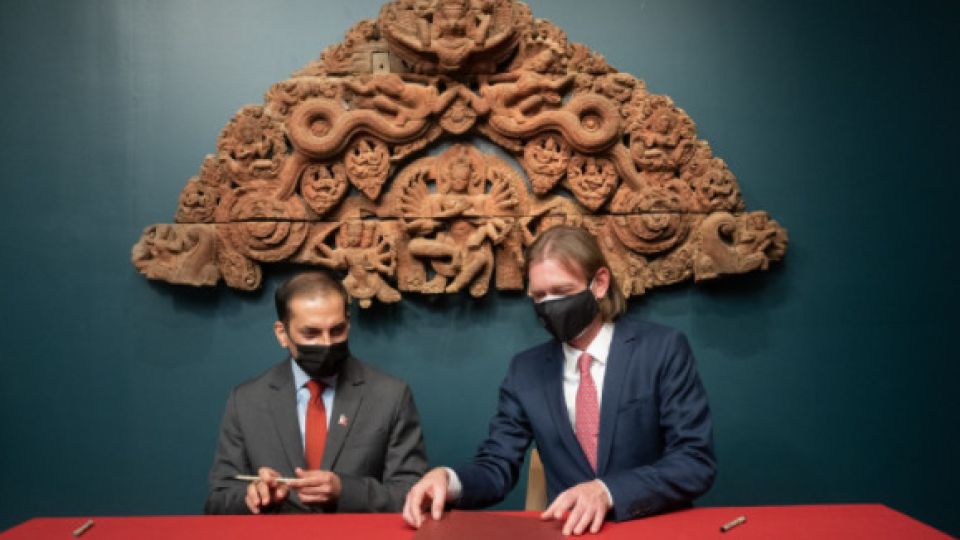January 12, 2022
KATHMANDU – onced dubbed an “open museum” by art historian Jurgen Schick for its abundance of high-quality art in public spaces, had for the very reason of being open become a haven for seekers of the relics, sculptures and ancient religious statuaries, which would fetch millions in the West.
Art-theft from Nepal started after the end of the Rana regime in the 1950s when the country opened up to the world. And the process began to be glaringly noticed after the 1960s. The Ancient Monument Preservation Act 1956 and subsequent amendments did little to prevent the theft of antiques, which peaked in the 1970s and 80s, and continued. But times are changing.
Some centuries-old relics, sculptures and idols, stolen and smuggled out of the country, are finding their way back home.
On Monday, the Rubin Museum of Art in New York announced that it would return two relics from its collection to Nepal after they were found to have been smuggled from two religious sites in Kathmandu Valley.
Bishnu Prasad Gautam, Nepal’s acting consul general in New York, and Jorrit Britschgi, executive director of Rubin Museum, signed a memorandum of understanding on returning the two sculptures—one 14th-century Flying Gandharva and another the upper section of a 17th-century Torana.
“The Rubin Museum has agreed to return the sculptures after we identified them and provided the required proof of their origins,” Gautam told the Post over the phone.

The upper section of a 17th-century Torana. Photo courtesy: Rubin Museum of Art/Filip Wolak
“Lost Arts of Nepal”, a group working towards identifying and locating lost artefacts from Nepal scattered around the world, in September said that it had located the two relics in the Rubin Museum.
Nepal Heritage Recovery Campaign then had written to the museum for the return of the artefacts. The Department of Archeology had provided inputs to determine the ownership and origin of the art works.
The museum said in a statement that these two relics were the first items in its collection that were found to have been unlawfully obtained, the New York Times reported.
According to museum officials, the Torana was lost from the main door of Yampi Mahavihara/I-Bahi, Patan, Lalitpur. The artwork arrived at the museum in 2010. The work of flying Apsara is originally from Keshchandra Mahavihara, Itumbahal, Kathmandu which was lost in 1999 and added to the museum’s collection in 2003, said the museum.
According to the Times, scholars working for the museum found that the garland went missing from the monastery in 1999, four years before it was purchased by the Shelley and Donald Rubin Cultural Trust, which represents the Rubin Museum’s founders.
Sandrine Milet, a spokeswoman for the museum, said the two artefacts were purchased in private sales but declined to name the dealers, saying they wished to remain anonymous, reported the Times.
Nepal’s Consulate General in New York in a statement said that collaborative efforts with the Rubin Museum contribute to the preservation of the cultural heritage, and further strengthen the long-standing people-to-people ties between Nepal and the United States of America.
“The Consulate General continues to work on the country’s national efforts in the repatriation of lost cultural properties,” reads the statement. “The Consulate General and the Rubin Museum express willingness to work closely in the promotion of art and culture, including Himalayan art.”
The Rubin Museum’s announcement to return the Nepali relics follows the return of a stone sculpture of the Hindu goddess Lakshmi-Narayan from Dallas Museum of Art. The androgynous idol, looted from Patan in the 1980s, was reconsecrated last month.

14th-century Flying Gandharva. Photo courtesy: Rubin Museum of Art/Filip Wolak
Britschgi, the executive director at the Rubin Museum, during the signing of the memorandum of understanding, said, “As custodians of the art in our collection, the Rubin recognises that we have an ongoing duty to carefully research the art and objects we collect and exhibit.”
“The theft of archaeological objects continues to be a major concern in the art world. The Rubin’s collecting activities adhere to the highest standards of ethical and professional practice related to provenance,” said Britschgi. “We believe it is our responsibility to address and resolve issues of cultural property, including helping to facilitate the return of the two objects in question.”
Gautam, on his part, expressed gratitude to the Rubin Museum.
“The proactive and warm response and thoughtful collaboration from the Rubin have positively contributed to Nepal’s national efforts to recover and reinstate the lost artefacts,” said Gautam. “I expressed my deep gratitude to the Rubin Museum, its executive director, Board of Trustees, the museum’s scholars and officials for their initiative and cooperation in returning these artefacts back to Nepal.”
Gautam also appreciated the support received from media, civil society, and others in the endeavour, according to the statement.
He dubbed the agreement signing yet another milestone in retrieving lost artefacts.
“The Rubin Museum has agreed to take care of the expenses of transporting the relics to Nepal,” said Gautam. “These two relics have already been removed from exhibitions.”
According to Gautam, the two sculptures are likely to arrive in Nepal within the third week of May.

